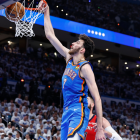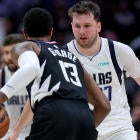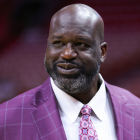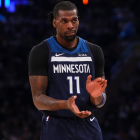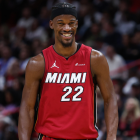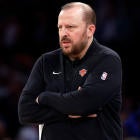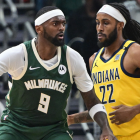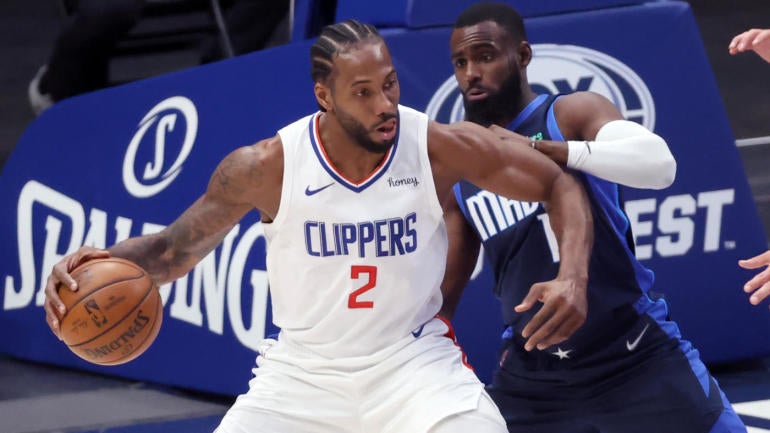
Kawhi Leonard is probably staying with the Los Angeles Clippers, but it's notable that the "probably" qualifier is now necessary. There was seemingly no chance that he'd leave the team he maneuvered so desperately to reach for most of the season, but slight rumblings stemming from a recent Marc Stein newsletter and later appearance on Greenroom have sent the message that, even if his return to Los Angeles is still by far the likeliest outcome, there are "teams that no longer make the blanket assumption that Kawhi will stay with the Clippers and plan to pursue him if they get the chance."
There's a chance that sentiment is just misplaced optimism. It might also come down to Leonard's notoriously quiet nature keeping the Clippers in the dark. He moved Heaven and Earth to get to Los Angeles. The assumption, until he gives us reason to believe otherwise, should be that he plans to stay there. But on the off chance that he doesn't, it's worth checking in on which teams might actually have the resources to pursue him.
The Mavericks, Heat and Knicks are all reportedly interested in Leonard if he considers teams besides the Clippers. They all, notably, have cap space. In all likelihood, any team hoping to add Leonard will need it. For a multitude of reasons, it appears unlikely that the Clippers would cooperate on a sign-and-trade that would get Leonard to a preferred destination. They have so few long-term assets that dealing him for things that would help with a rebuild would be practically pointless. Their only hope of sustained contention lies with Leonard.
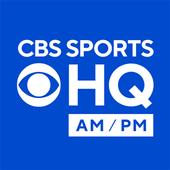
CBS Sports HQ Newsletter
Your Ultimate Guide to Every Day in Sports
We bring sports news that matters to your inbox, to help you stay informed and get a winning edge.
Thanks for signing up!
Keep an eye on your inbox.
Sorry!
There was an error processing your subscription.
So realistically, teams in pursuit of Leonard are going to need the cap space to sign him outright. That's not going to be easy. His maximum salary as a 10-year veteran is over $39.3 million, and before you suggest teams might be afraid to pay it given his injury history, remember, Kevin Durant got the max in 2019 with a torn Achilles. Those are far more dangerous than any injury Leonard has ever suffered. So let's take a look at the teams that have been linked to him in the past and whether or not they could feasibly create the space that they would need to sign him, should the (very unlikely) opportunity arise.
New York Knicks
The question for the Knicks isn't whether or not they can afford Leonard. They can create roughly $50 million in space by renouncing their own free agents, more than any other team in the NBA. The real question is how they can use the rest of their space to potentially entice Leonard into signing in New York. If Leonard is filling a max slot, the Knicks won't have the space to sign another high-level player in free agency, but they could still weaponize what was left to put a deeper roster around him.
They could, for example, use some of that space to retain key players from last year's team. For example, Nerlens Noel ($6 million) and Reggie Bullock ($5.5 million) have fairly small cap holds. The Knicks could keep them on the books, sign Leonard, and then re-sign both to multi-year deals afterward. If Leonard had his heart set on playing with Derrick Rose, the Knicks could keep him and his $10 million cap hold instead. If there are other outside role players he'd like the Knicks to chase, including former teammate in San Antonio and Toronto Danny Green, that could be an option for them as well.
They wouldn't have the remaining cap space to sign an expensive free agent outright but they could pursue one through a sign-and-trade using some of their own remaining salary. Let's say Leonard wanted to reunite with Raptors teammate Kyle Lowry. The Knicks could negotiate a sign-and-trade with Toronto that would send some of their existing contracts, including Obi Toppin ($5.8 million), Kevin Knox ($5.1 million) or even young center Mitchell Robinson ($1.8 million on a team option) to either the Raptors or a third party to open up the space necessary to fit him in. This is a significantly more complicated procedure, but the basic point is that the Knicks have so much space that they can conceivably pair Leonard with almost any 2021 free agents they want to.
There just aren't any other superstars in the 2021 free-agent class to truly entice Leonard to New York. That, ultimately, would be their best bet. If they want to land Leonard, they're likely going to have to find him a suitable co-star through a trade. No obvious candidates exist if Damian Lillard and Bradley Beal aren't available, but Paul George wasn't available in 2019 either. Leonard's recruiting changed that. If he wants a new partnership in New York, odds are, he'll be able to find a running mate.
Dallas Mavericks
The first order of business for Dallas if they hope to get into the Leonard sweepstakes is to make sure that Josh Richardson isn't on the roster next season. His $11.6 million player option is their biggest obstacle to max cap space. If he declines that option, Dallas is starting with roughly $32 million in space, and it gets easier to shed the rest from there.
The $4.1 million owed to Willie Cauley-Stein is non-guaranteed, and Dallas won't hesitate to waive him if necessary. Trey Burke's $3.3 million is easily tradable as plenty of teams have either the cap space or a trade exception capable of absorbing it, but if necessary, they could also waive-and-stretch the remaining $6.7 million on his deal over the next five seasons to shed more than $1 million in space right now. The same could be said of 2020 first-round pick Josh Green. If Dallas had to move his $3 million salary, doing so wouldn't be a problem. Without Richardson, creating max cap space is fairly straightforward for Dallas.
If Richardson opts in? Then things get more complicated. The Mavericks would almost certainly have to trade a mid-tier salary in order to get to the max. Richardson, Dwight Powell ($11 million) and Maxi Kleber ($8.8 million) would all be candidates. All three are valuable rotation players, but that has never stopped teams from gouging desperate cap dumpers. If it took a first-round pick for Golden State to get off of Andre Iguodala in 2019, there's a good chance it would take a first-round pick for Dallas to get off of one of these salaries in 2021. That is somewhat problematic for the Mavericks considering the protections on the 2023 first-round pick they owe to the Knicks. At present, they can't trade another first-rounder until 2027 due to the Stepien Rule. If they want to trade an earlier pick, they would have to remove the protections on their 2023 selection. The Mavericks would likely have a low pick with Luka Doncic and a healthy Leonard leading them for the 2022-23 season, but Dallas isn't exactly asset-rich. Giving up a pick stings.
But if the Mavericks got a firm commitment from Leonard, creating the space wouldn't be an issue. It's doable without too much pain. The next two teams on this list would have a harder time here.
Miami Heat
Dallas would have to work to create max cap space. The Heat literally can't get there as long as their two All-Stars remain on the team. Jimmy Butler will make $36 million next season. Bam Adebayo is owed $28.1 million. The Heat have $5.2 million in dead money after they stretched Ryan Anderson in 2019 to fit Butler under the hard cap. Even if you removed literally every player on the roster aside from Butler and Adebayo, the most cap space Miami can generate is roughly $33.8 million once 10 incomplete roster charges are factored in.
The Heat have known this would be the case for quite some time. Had they not extended Adebayo last offseason, they still would have been able to retain him as a restricted free agent, but his cap hold would have been $15.3 million before signing a new deal this offseason. Instead, his cap figure is almost $13 million higher at $28.1 million. That is the difference between having max space and not, as Leonard's $39.3 million max is around $5.5 million more room than the Heat can generate. I explained Miami's decision to willingly sacrifice cap space in order to re-sign Adebayo in-depth here, but this is the two-part short explanation for why they did it:
- Adebayo shares an agent, Alex Saratsis, with Giannis Antetokounmpo, who had not yet re-signed with the Bucks. Miami had planned to pursue him, so keeping his agent happy was seemingly a priority.
- Teams frequently ask their third-year stars to wait until restricted free agency to sign their second contract as a way to save cap space, and it often blows up in their faces. A really relevant example of that is Leonard himself. He was eligible for a contract extension after the 2014 championship, but the Spurs forced him to wait until 2015 because they wanted to save space for LaMarcus Aldridge. Leonard's relationship with the team deteriorated for other, publicly known reasons, but that decision easily could have been the inciting incident.
Of course, to an extent, this is irrelevant. The Heat are unlikely to clear every salary except for Butler and Adebayo off of their books. Right now, they're looking at around $21 million in space with contracts for Tyler Herro, Precious Achiuwa, KZ Okpala and Omer Yurtseven on their books and cap holds for Duncan Robinson and Kendrick Nunn still in place as well. The Heat can create more room by pulling the qualifying offers on Duncan Robinson and Kendrick Nunn. This would lower their cap holds from $4.7 million down to $2.1 million and get them to roughly $27 million in space, but it would make those two unrestricted free agents rather than restricted ones. Miami could work around this by verbally agreeing to extensions with both early, but signing them last in order to maximize their low cap holds. Let's say they took the more realistic path of retaining Herro, but getting off of Achiuwa, Okpala and Yurtseven and renouncing all of their other free agents. That would leave the Heat with around $28.4 million in space to throw at Leonard.
That's not the max. It's significantly lower than the max, in fact, but if Leonard was desperate enough to get to Miami, there's a way the Heat could get closer over the long haul. Once a player has spent one year on a new team after signing there in free agency, they are eligible for a 20 percent raise on a new deal through Non-Bird Rights and a 75 percent raise through Early Bird Rights. If Leonard signed a one-year deal with a player option for a second season, he could position himself to jump from $28.4 million in the 2021-22 season to $34 million in the 2022-23 season through those Non-Bird Rights.
He could, at that point, sign a hefty four-year deal at a still considerable price, or he could jump up to $34 million, take another one-year deal, and then, through his Early Bird Rights, try to get up to the max afterward. There is definitely some risk in that plan if Leonard gets hurt again, but it is a feasible path he could take to something close to max money in Miami down the line. If he knows that he is going to sit all of next season out (which, to be clear, is no certainty), he could come to a wink-wink agreement with the Heat that they would give him a new deal starting at that $34 million figure in the 2022 offseason without having to risk re-injury on the floor before that.
Still, the Knicks and Mavericks have clear paths to the max. The Heat don't. That makes them significant underdogs if Leonard wants to find a new team.
Toronto Raptors
No reports, to this point, have linked Leonard to the Raptors, but they're worth a brief look here considering their history. If nothing else, the two sides had a mutually satisfactory relationship in 2019, when Leonard led the team to the championship and the organization, in turn, kept him healthy after what was essentially a lost final season in San Antonio. There seemed to be trust between Leonard and Toronto's medical staff, a factor that shouldn't be overlooked. If Leonard wanted to remain with the Raptors, he likely would have done so in 2019, but on the slim chance he'd be open to a return now, we'll at least examine the finances.
In the bare bones scenario, the Raptors can get to just below $27 million in space. This would mean waiving all of their non-guaranteed players and renouncing most of their own free agents, including Lowry. They would only keep the four players currently under guaranteed contracts for next season: Pascal Siakam, OG Anunoby, Fred VanVleet and Malachi Flynn, along with the No. 4 overall pick and the $2.1 million cap hold of Gary Trent Jr. (which could only get that low if Toronto pulled the qualifying offer and made him unrestricted, as Miami did with Robinson and Nunn in the scenario above). That isn't max space, but unlike the Heat, Toronto could feasibly get there through a trade. It would just be a painful one. Essentially, the Raptors can only get to max space by trading one of their three core veterans: Siakam, Anunoby and VanVleet.
That doesn't necessarily mean that they can't take any money back. Siakam is making max money himself, so the Raptors could conceivably trade him for a player making roughly half as much in order to create the room needed for Leonard. There would be far more interest in Anunoby and VanVleet, though. Perhaps the Raptors could swap one of them to one of the younger teams with space (the Knicks, Thunder, Spurs, Hornets or Grizzlies) in exchange for a valuable younger player on a rookie contract. Finding a deal wouldn't be hard. It would just make the Raptors less appealing.
That, aside from geography, is what makes a Raptors reunion so unlikely. Four of the key teammates that Leonard won the title with (Lowry, Green, Marc Gasol and Serge Ibaka) are already gone. If another joins them, he'd be signing with a completely different roster. The Raptors can create max space, but doing so with a roster Leonard would be interested in joining might be another matter.
Teams that could afford Leonard, but that he wouldn't consider playing for
I briefly mentioned the Spurs and the Thunder as possible partners in cap-clearing trades. Both make sense because both could easily get to max space if they wanted to. The Spurs can create nearly as much space as the Knicks, around $48 million. The Thunder are slightly below the max right now at roughly $38 million, but would only need to waive the non-guaranteed contract of Gabriel Deck to make up the difference.
The only problem here is that Leonard wouldn't consider joining these teams. Never say never in the modern NBA, but Leonard burying the hatchet with Gregg Popovich and returning to the Spurs would be among the least likely things that have ever happened in free agency. The Thunder will be appealing down the line, but right now, they are in the thick of a rebuild. Leonard wouldn't leave the Clippers for a non-contender in a small market.
Teams that Leonard might be interested in, but couldn't afford him
Since people are inevitably going to ask about these teams, let's just knock them out quickly:
Leonard could have signed with the Lakers for the max in 2019. That's no longer remotely the case. Even if they traded every player on their roster except for LeBron James and Anthony Davis, they'd still have below $22 million in cap space to offer. Realistically, the Lakers are using the taxpayer mid-level exception this season. If they splurge, it will be through a sign-and-trade for a non-max player.
The Nets and the Warriors are so deep into the tax that it's not even worth covering the steps it would take to create max space. In fact, both of them are more than a full max salary above the cap for next season. Brooklyn is around $44 million above the cap, and Golden State is even pricier with a roster that is currently $55 million above the cap. Both teams will make other moves this offseason that make their rosters more expensive. Even if there are Leonard sweepstakes, these teams aren't getting into them.















